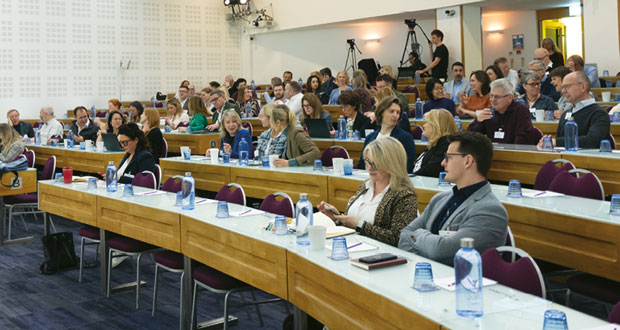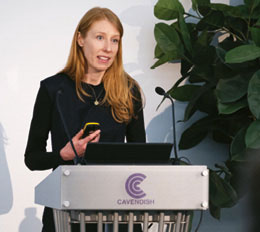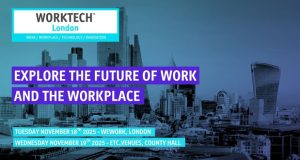“We’re here to learn today” said Psychologist and Workplace Consultant Nigel Oseland in his introduction to the Workplace Trends Spring Summit 2024. A selection of data rich presentations ensured we did
What we want out of our office is what unites us, was the message of Kerri Henderson and Naomi Sakamoto of Gensler. They posed the question ‘if the last three years has shown most office work can happen at home, what is its value?’ The answer is that the office remains one of the few places where people come together in social groups with people they didn’t choose, so rather than confining ourselves to communicating with people who agree with us, we’ve an opportunity to create more diverse and the research suggests, more productive groups.
Iain Shorthose and Steven O’Leary of Paragon Workplace Solutions shared their report, The Chameleon Workplace which asked, ‘have we still an opportunity to use the workplace as a competitive advantage as part of the employee value proposition?’ Worryingly their study revealed only 39 per cent of employees think the workplace was designed with them in mind, compared to 70 per cent of top executives who believe this. If we just design the workplace for the most senior people in the organisation they warned this results in a HIPPO (Highest Paid People in the Office) bias which could impact recruitment and retention.
AI & VISUAL
The role of AI in the workplace was a big talking point of the day, and as O’Leary of Paragon pointed out, it is not something we need to survive but to help us to thrive. Paul Urmston, Area Workplace Manager at NatWest Group and Ian Ellison of Audieum, described how AI-powered workplace experience analytics has helped the banking group collate a mass of occupier feedback. As Ellison concluded, utilising an AI platform that processes multiple inputs can provide actionable insights that help improve the workplace environment.
Taking a visual approach to tech, Maria Tam, Spacial Psychologist at MAKE Architects presented research into how the positioning of video units affect informal interactions between globally dispersed workers. Put another way, it assessed ways online communications can be designed to make us feel less awkward. “If this all seems too futuristic”, said Tam, “consider the fact we are designing fitouts in buildings to last five, 10 or 50 years and with virtual communications tech being updated from one year to next – the spaces we design need to be adaptable now to meet our hybrid future.”
In another visual take, Dr Harriet Shortt of the University of the West of England and Head of Visual Engagement, Bibo Studio presented research based on participant-led photography. This focused on staff within a large housing group who shared pictures that illustrate their everyday experiences of workspaces – both at home and in the office. Using these visual methods afforded some unique insights on workers’ personal journeys since home/office work patterns took hold. Two key takeaways were the importance of food and drink to connect us and how we need to offer office workers more opportunities to curate their space at work as well as at home.
FUTURE THINKING
Taking a broader perspective, Mark Catchlove presented findings from the Copenhagen Institute for Futures Studies and MillerKnoll on four possible future scenarios for urban living. His rationale was if we can understand the outside world of the cities, we then can start to think about what that means for places where people live, play and work. The idea he said is to “provoke people to decide which scenarios they like and don’t like and help make the positive ones happen”.
Hybrid ways of working are already impacting our cities, but the adoption of flexible working isn’t new, said Andy Lake, Author and Founder of Flexibility.co.uk and Smart Work Network who asked, ‘is it more of a case of old dog, new tricks?’ In a presentation touching on 30 years of studies into flexible working (including ‘teleworking’ from the 90s) he suggested “there is a following wind for the decentralisation of work and we have to embrace this, learning from what works well to innovate further”.
INCLUSIVE DESIGN
The conference was rounded off with two presentations on inclusive design. Matteo Zallio from the University of Cambridge revealed that design practitioners reported a lack of client awareness on the benefits of inclusive design, despite the research showing that for every £1 invested in this area, there was a return on investment of £100.
Empathy in design is talked about a lot said Kim Hutton, Ergonomist & Chartered Physiotherapist at Human Connections but how is it measured? By giving architects a set of tasks which they had to perform while wearing eye glasses and gloves that simulated loss of visual acuity and hand dexterity, the research revealed the barriers still faced by many people for whom inclusive design is supposed to help.
The main appeal of the Workplace Trends Spring summit is that most of the content is curated from recent applied research and data-driven case studies. This resulted in not only useful but actionable insights for workplace leaders operating in an uncertain world.
https://workplacetrends.co/events/workplace-trends-research-summit






